Author: Mr A
Wednesday: I’m back! After flying in yesterday from the UK, it was a fuzzy start for me this morning. I left my home town of Kettering (just south of Birmingham) at 3pm Sunday night, and arrived yesterday afternoon (Tuesday) at our camp site 50km south of Darwin. It was quite a trip – 44 hours door to door – and involved 2 car shuttles, 3 train journeys and 3 flights! The worst part was flying over the top of Darwin during the early hours of Tuesday morning transiting from Singapore to Melbourne, and then spending half a day flying back up to Darwin.
Well off we went this morning anyway, with no firm plan of how far we would go. Thankfully I felt pretty good, so we made it to just south of Katherine and landed the last decent spot in a free camp. It was a great feeling to be back on the road again with my two travel mates (I count Miss Tasmania of course!).
Thursday: As I stuck my head of the Zone, I spotted a couple of cyclists having a feed. Of course I had to go and have a natter. An hour later…Catherine comes to find me. These guys have ridden across from Perth, up to Darwin and now to the east coast. I find it fascinating that people choose to cycle these massive distances, often across the featureless plains that go on for mile after mile across our interior. They have to dance with the road trains thundering along by the side of them, brave the extremes of temperature, the lack of facilities. Why do they do it? Isn’t that always the intriguing question with any challenge in life?
The Daly River Pub loomed at lunchtime and it was rude not to call in for more barramundi, before continuing on our way south.
 Anyway, it was a long day in the saddle, but we pulled up finally at a place we had stopped at on the way north last year. It’s just an old road that loops off the Stuart Highway for about 5km, signposted ‘Churchill’s Head’.
Anyway, it was a long day in the saddle, but we pulled up finally at a place we had stopped at on the way north last year. It’s just an old road that loops off the Stuart Highway for about 5km, signposted ‘Churchill’s Head’.
 No facilities, just a level bit of ground a view across the plains. We loved it last time, and we love it again. There seem to be so few places like this on the well trodden routes we have been following. For a start there are very few minor roads that lead off the main highway, so we are drawn to caravan parks or the crowded free camps often so close the highway that the road trains sound like they are coming right through the Zone! “Ah..the serenity”, to quote from one of our favourite movies “The Castle”.
No facilities, just a level bit of ground a view across the plains. We loved it last time, and we love it again. There seem to be so few places like this on the well trodden routes we have been following. For a start there are very few minor roads that lead off the main highway, so we are drawn to caravan parks or the crowded free camps often so close the highway that the road trains sound like they are coming right through the Zone! “Ah..the serenity”, to quote from one of our favourite movies “The Castle”. If we were to walk out of the van due west we wouldn’t reach another tarmac road for 1,325km – on the west coast of Australia, south of Broome. Not one hint of civilisation, except the Alice to Darwin railway. Nothing else. What a country. How many places in the world still have that amount of emptiness?
If we were to walk out of the van due west we wouldn’t reach another tarmac road for 1,325km – on the west coast of Australia, south of Broome. Not one hint of civilisation, except the Alice to Darwin railway. Nothing else. What a country. How many places in the world still have that amount of emptiness?
Friday: An early start and our excitement for the day would be a wander around Karlu Karlu (also known as the “Devils Marbles”), a pretty unusual geological formation of granite boulders.
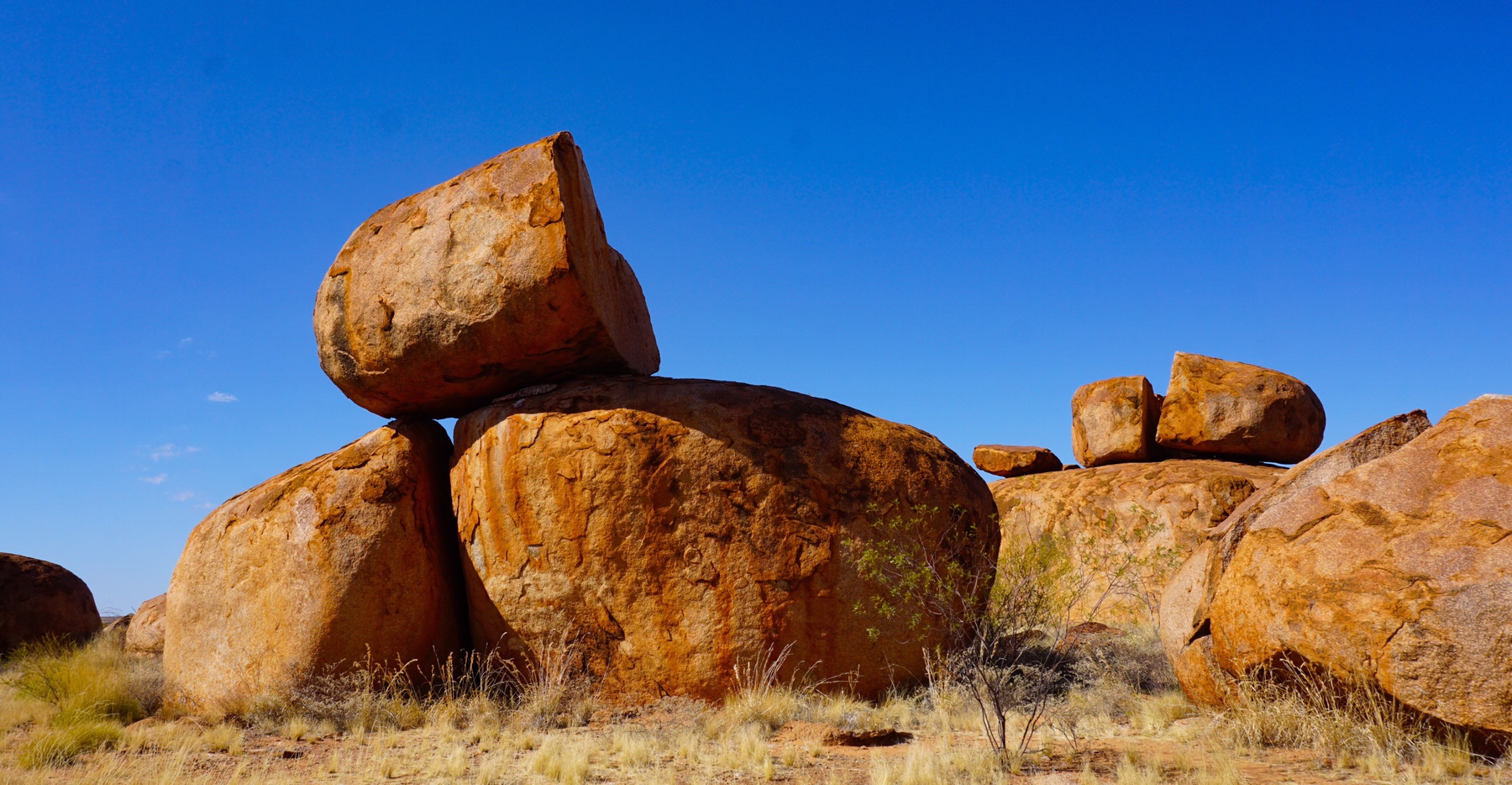


 Then after lunch we were through Tenant Creek, only stopping for the dump point, and by late afternoon arriving at our camp for the night in a small service centre for the surrounding aboriginal communities called Ti-Tree. Guess what sort of trees grow here?
Then after lunch we were through Tenant Creek, only stopping for the dump point, and by late afternoon arriving at our camp for the night in a small service centre for the surrounding aboriginal communities called Ti-Tree. Guess what sort of trees grow here?
The camp is actually a “gated community” for caravans – apparently this is a high crime area so a tall fence has been built around the whole site! Another “functional” camp on our dash down the Stuart Highway from Darwin to Alice.
Tonight is forecast to drop to 5 degrees – which is going to be a shock considering last night was 21! An amazing variation in temperature in a day’s drive.


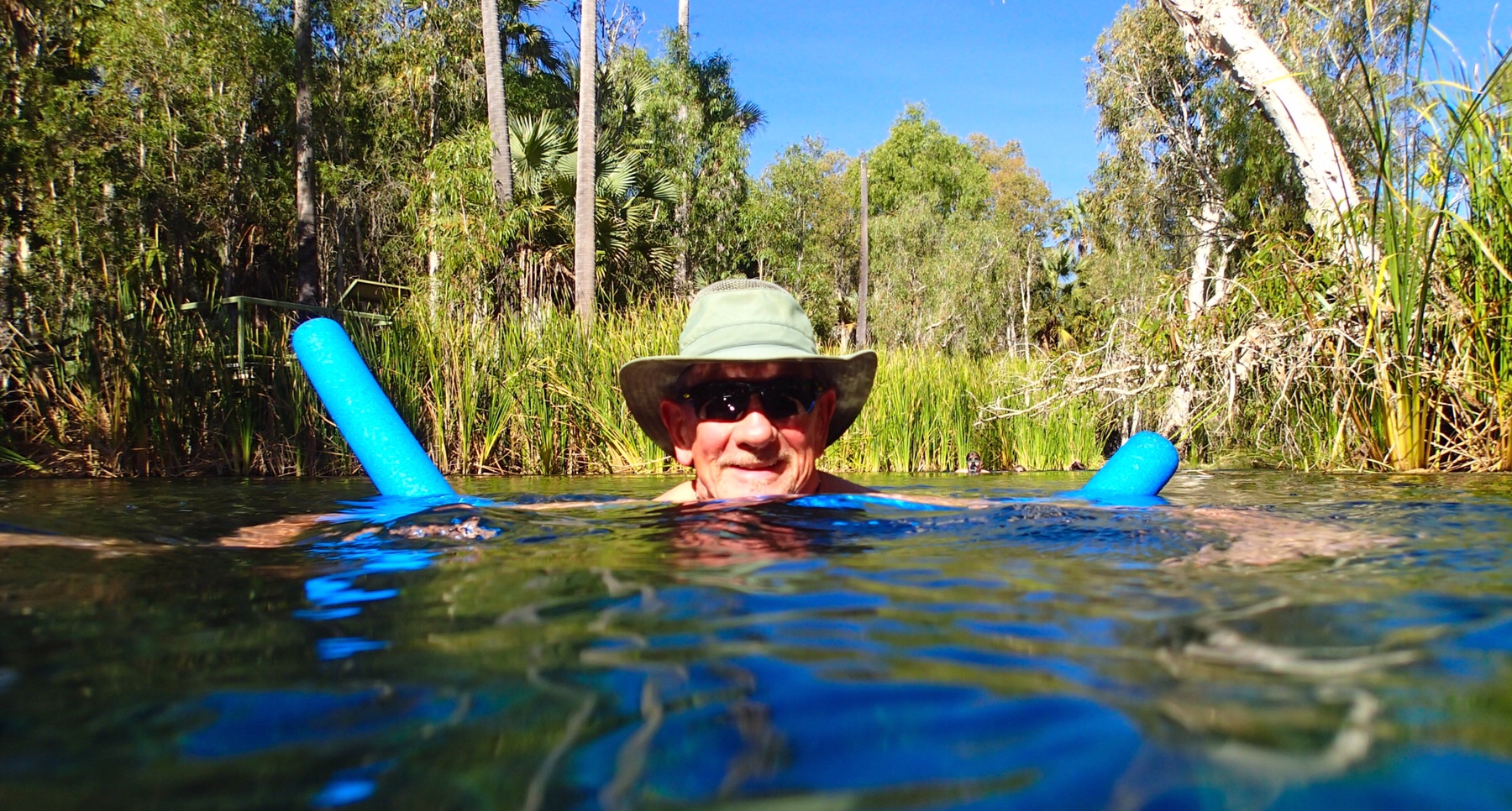 After all the heat and dust of the past few days, this was just what the doctor ordered. We swam up the warm river about 20 metres and were soon away from the crowds and had a lagoon all to ourselves. Just bliss. This has to be a stop over if you’re heading this way.
After all the heat and dust of the past few days, this was just what the doctor ordered. We swam up the warm river about 20 metres and were soon away from the crowds and had a lagoon all to ourselves. Just bliss. This has to be a stop over if you’re heading this way.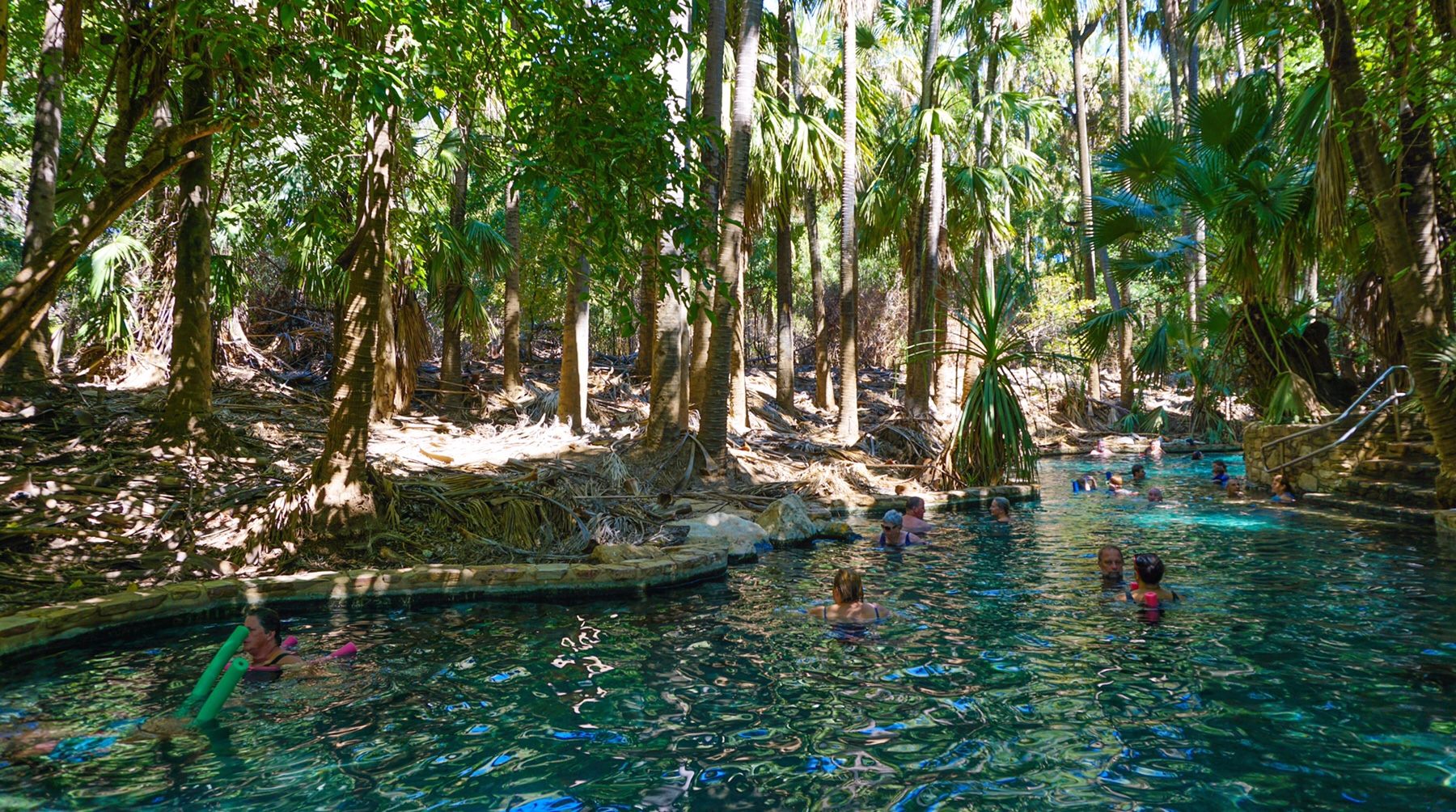 We did a short walk along the river before returning to Bitter Springs for a dip in the serenity.
We did a short walk along the river before returning to Bitter Springs for a dip in the serenity.
 Top tips for visiting Bitter Springs (Stay at Bitter Springs Caravan and Camping):
Top tips for visiting Bitter Springs (Stay at Bitter Springs Caravan and Camping):

 Just one small part of the 40km square area is open to visitors, but it offers a fabulous window to some of Australia’s evolution. Harking back to times when this dry dusty area was instead rich rainforest peppered with spring-fed lakes and pools – now limestone beds packed full of fossilised bones.
Just one small part of the 40km square area is open to visitors, but it offers a fabulous window to some of Australia’s evolution. Harking back to times when this dry dusty area was instead rich rainforest peppered with spring-fed lakes and pools – now limestone beds packed full of fossilised bones.
 The national park seems to be in cahoots with Adels Grove, with a lot of encouragement for visitors to do a paid trip with a tour guide. We tried to get on a tour but none were running, so we did a self-guided visit. There was very limited information provided on boards, and may fossils with no details beside them. You had to use a lot of imagination to understand what you’re looking at, and a lot of Googling later on when we finally got enough phone signal to connect to internet.
The national park seems to be in cahoots with Adels Grove, with a lot of encouragement for visitors to do a paid trip with a tour guide. We tried to get on a tour but none were running, so we did a self-guided visit. There was very limited information provided on boards, and may fossils with no details beside them. You had to use a lot of imagination to understand what you’re looking at, and a lot of Googling later on when we finally got enough phone signal to connect to internet.

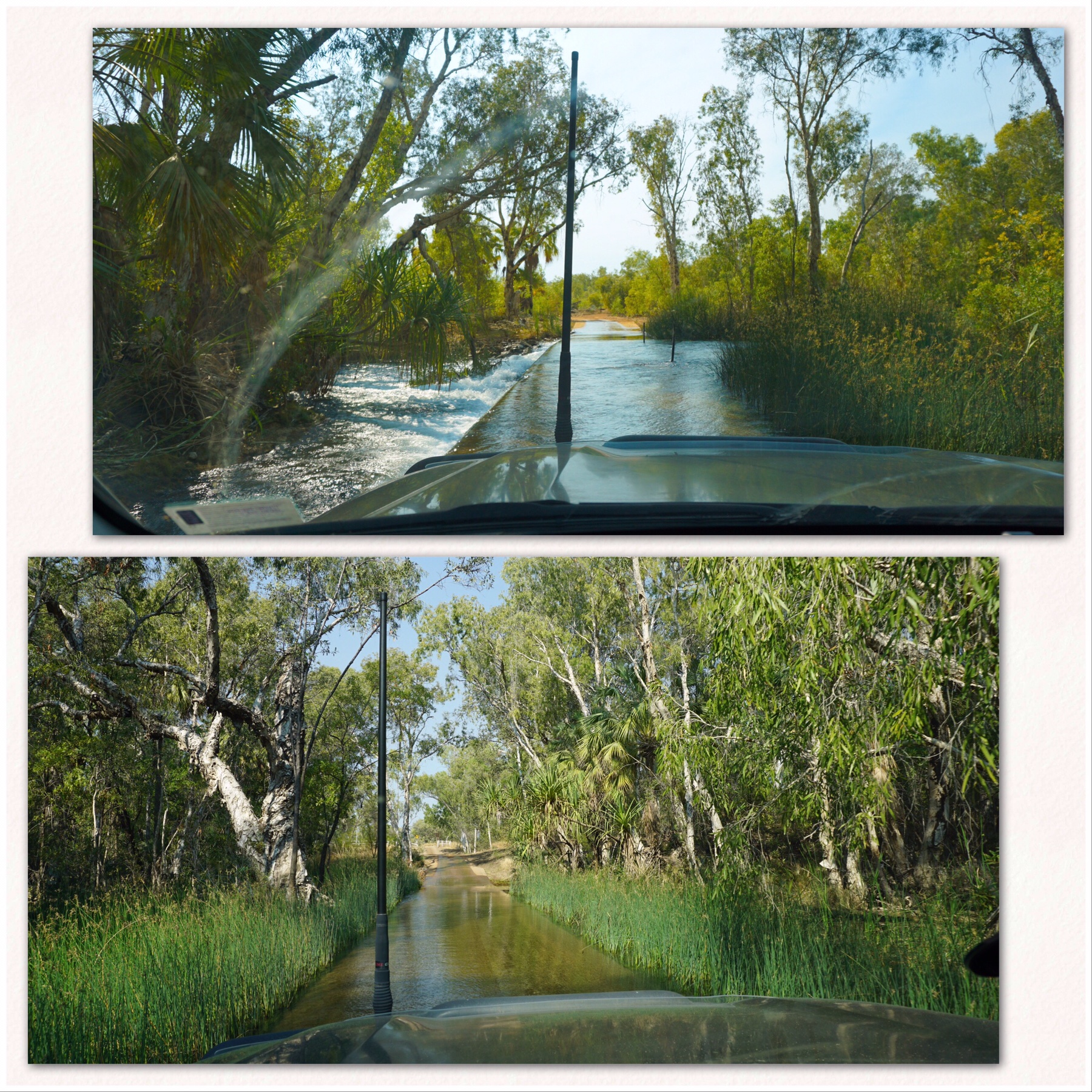 It was a slow old journey which led eventually to tarmac, and then another 200km to our destination for the night, Camooweal. There we did a massive clean, inside and out, to try and rid ourselves of some of the red dust we had accumulated over the past few days.
It was a slow old journey which led eventually to tarmac, and then another 200km to our destination for the night, Camooweal. There we did a massive clean, inside and out, to try and rid ourselves of some of the red dust we had accumulated over the past few days.
 It is amazing how many caravans are on the road – it is not even school holidays any more, and everywhere is heaving. Stations like this are literally raking the money in. We park in rows in a paddock, each van having access to water, a shower and toilet block, and a country music singer around the campfire at night. All this for $20 a van – that’ll be around $1,500 dollars per night earned…not bad for a patch of dirt.
It is amazing how many caravans are on the road – it is not even school holidays any more, and everywhere is heaving. Stations like this are literally raking the money in. We park in rows in a paddock, each van having access to water, a shower and toilet block, and a country music singer around the campfire at night. All this for $20 a van – that’ll be around $1,500 dollars per night earned…not bad for a patch of dirt. Before long we had backed the caravan into the workshop and Mr A was inflating tyres as Bushy did his work, welding the new brackets to the front right hand side of the van. He did a thorough check of all the other brackets, and added some extra weld where he felt needed the strength.
Before long we had backed the caravan into the workshop and Mr A was inflating tyres as Bushy did his work, welding the new brackets to the front right hand side of the van. He did a thorough check of all the other brackets, and added some extra weld where he felt needed the strength.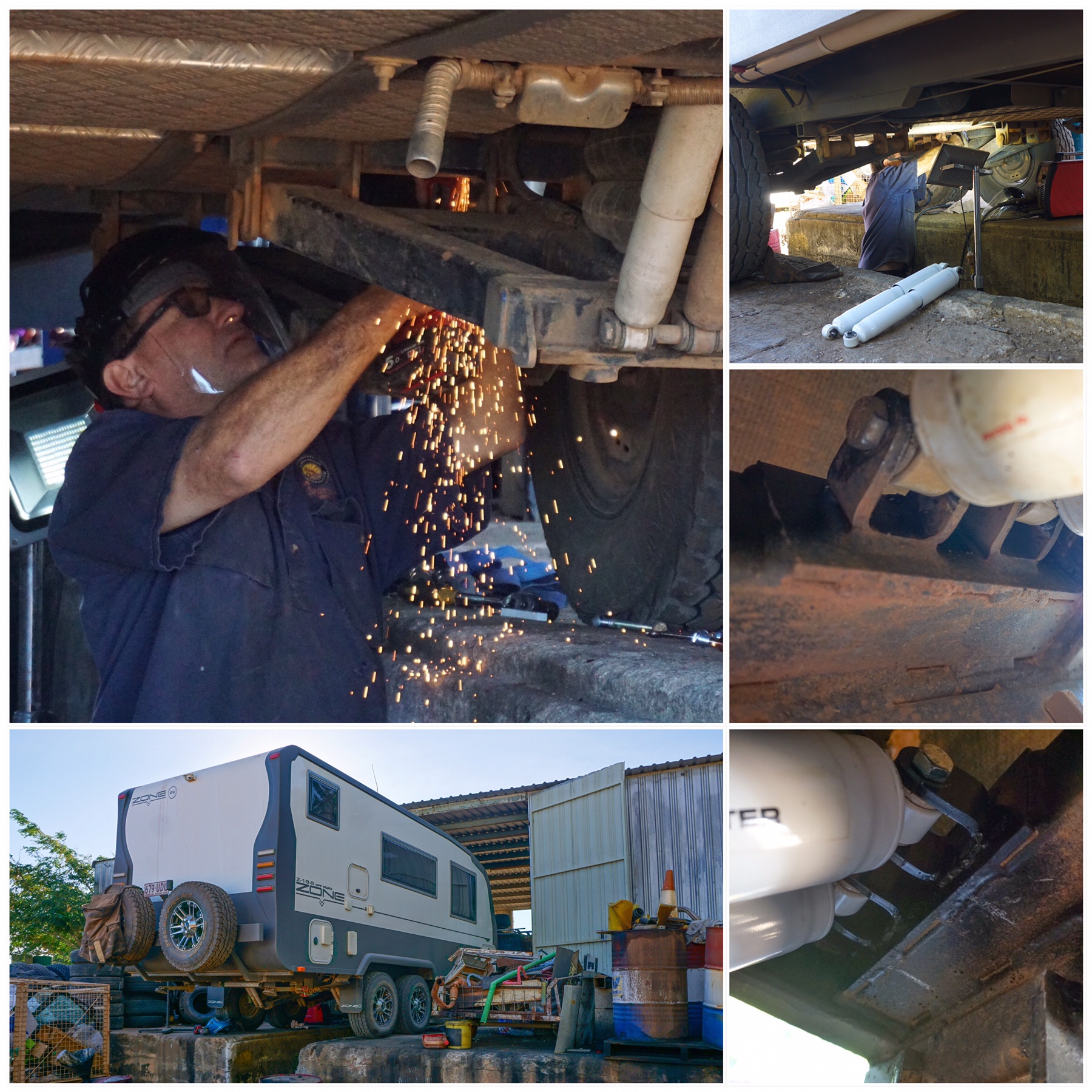 By the time we pulled out at about 10.30am we felt happy that all was securely in place and Bushy reassured us it should stay that way for the foreseeable future.
By the time we pulled out at about 10.30am we felt happy that all was securely in place and Bushy reassured us it should stay that way for the foreseeable future. The air feels lest dusty up here, and it is so good to see the ocean again.
The air feels lest dusty up here, and it is so good to see the ocean again. There’s a lovely looking Tavern right on the water front, with a surprisingly interesting menu. It has a large beer garden overlooking the water and sunset, and we have earmarked a couple of seats for tomorrow afternoon.
There’s a lovely looking Tavern right on the water front, with a surprisingly interesting menu. It has a large beer garden overlooking the water and sunset, and we have earmarked a couple of seats for tomorrow afternoon. We returned to camp to watch the sunset over the wetlands, before making dinner with our fresh veg. We watched the whistling kids flying in for the fish scraps being shared by those lucky enough to catch something today. The birds swooped down and caught snacks tossed in the air – quite a sight.
We returned to camp to watch the sunset over the wetlands, before making dinner with our fresh veg. We watched the whistling kids flying in for the fish scraps being shared by those lucky enough to catch something today. The birds swooped down and caught snacks tossed in the air – quite a sight. Mr A had more funeral arrangements to make and accomodation to book in the UK…I dread to see what our mobile phone bill will be this month after all these calls! This is a beautiful change of scenery for us though, and we think we’ll enjoy our stay here.
Mr A had more funeral arrangements to make and accomodation to book in the UK…I dread to see what our mobile phone bill will be this month after all these calls! This is a beautiful change of scenery for us though, and we think we’ll enjoy our stay here.
 Undara is Aboriginal for ‘long way’, and is the name given to Undara Volcanic National Park when it was established in 1993. It’s interesting they chose to give it an Aboriginal name, since there is no evidence of any Aboriginal habitation, visitation or use in the direct vicinity. Still, I’m pleased there some nod of acknowledgement to the traditional custodians of this land, who suffered great losses at the hands of the original settlers.
Undara is Aboriginal for ‘long way’, and is the name given to Undara Volcanic National Park when it was established in 1993. It’s interesting they chose to give it an Aboriginal name, since there is no evidence of any Aboriginal habitation, visitation or use in the direct vicinity. Still, I’m pleased there some nod of acknowledgement to the traditional custodians of this land, who suffered great losses at the hands of the original settlers. The sun soon came out and the dry landscape lit up with the coppery tones of the iron filled granite contrasting with the jet black basalt. It’s all quite different to the rich and green landscape of the past few weeks and we are really noticing the impact of the rain shadow cast by the Great Dividing Range along the coast.
The sun soon came out and the dry landscape lit up with the coppery tones of the iron filled granite contrasting with the jet black basalt. It’s all quite different to the rich and green landscape of the past few weeks and we are really noticing the impact of the rain shadow cast by the Great Dividing Range along the coast. 
 Before long, we were entering the first tube, clambering down piles of rubble left from a roof collapse. We were all too aware of the many tons of basalt over our heads, held together by little other than the compressive strength of the arch. Should the keystone break, then our travels would have ended right here.
Before long, we were entering the first tube, clambering down piles of rubble left from a roof collapse. We were all too aware of the many tons of basalt over our heads, held together by little other than the compressive strength of the arch. Should the keystone break, then our travels would have ended right here. Fortunately for us, today was not that day, and we lived to explore another tunnel, this one around 1.3km in length, winding its way along an old watercourse. Bats, moths, cockroaches and cane toads are among the known (and seen) residents of these tunnels, and the colours are fabulous.
Fortunately for us, today was not that day, and we lived to explore another tunnel, this one around 1.3km in length, winding its way along an old watercourse. Bats, moths, cockroaches and cane toads are among the known (and seen) residents of these tunnels, and the colours are fabulous. Memories of my Uni Geography degree came back in troves, with images from text books flashing through my head, not revisited for more than 25 years! We both really enjoyed the visit – yes, it was pricey at nearly $60 a head for two hours, but we felt well educated at the end of it and further immersed in some of the geological history of Australia.
Memories of my Uni Geography degree came back in troves, with images from text books flashing through my head, not revisited for more than 25 years! We both really enjoyed the visit – yes, it was pricey at nearly $60 a head for two hours, but we felt well educated at the end of it and further immersed in some of the geological history of Australia. We decided to go for a stroll and what did we see? None other than a couple of handsome male cats on leads exploring. See folks – it’s not just us!
We decided to go for a stroll and what did we see? None other than a couple of handsome male cats on leads exploring. See folks – it’s not just us!
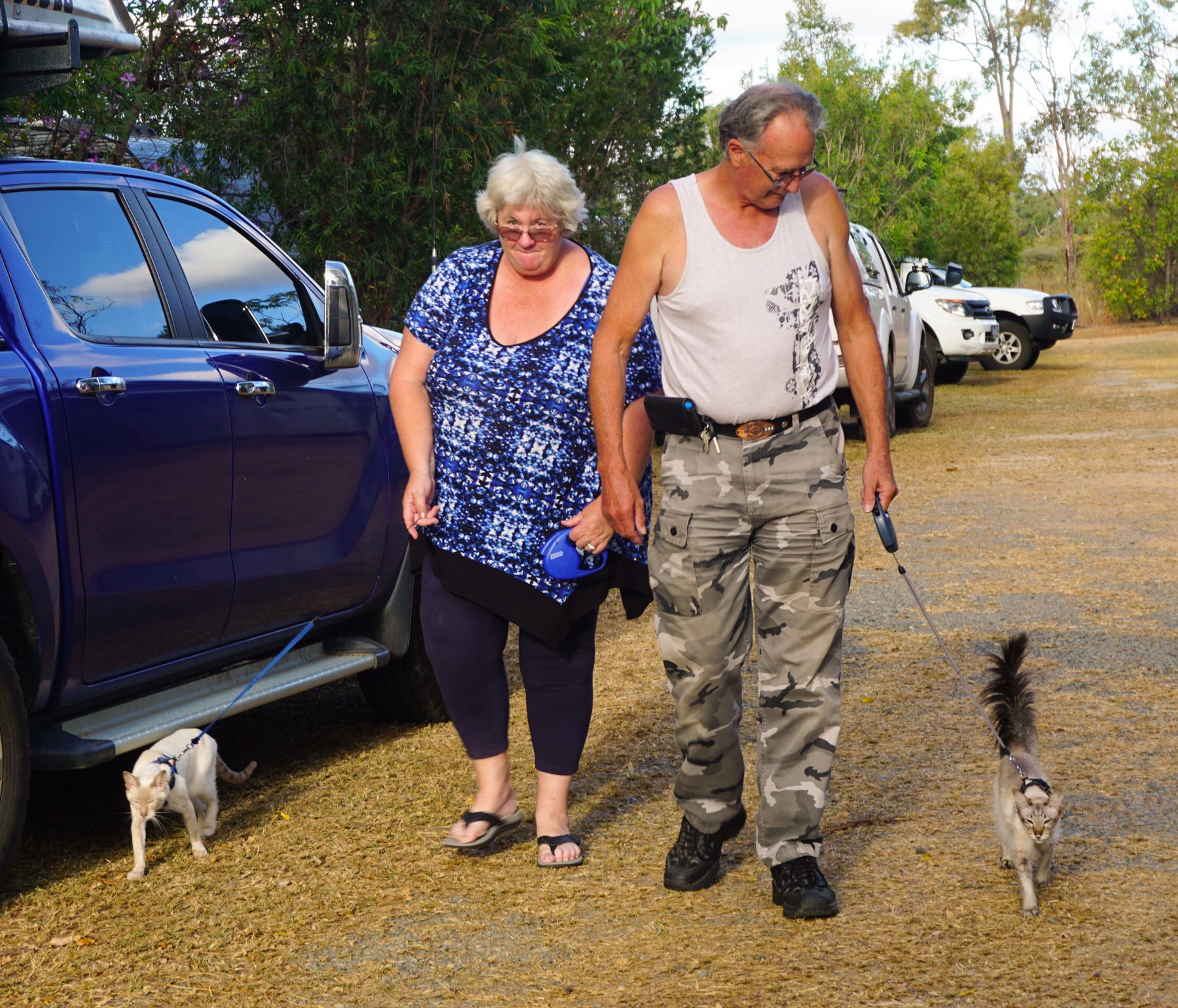 We continued our walk as the sun lowered in the sky, spotting birds and just enjoying the feeling of sun on our skin. As nostalgic as the rain and drizzle has made us feel, we really do appreciate the warmer weather!
We continued our walk as the sun lowered in the sky, spotting birds and just enjoying the feeling of sun on our skin. As nostalgic as the rain and drizzle has made us feel, we really do appreciate the warmer weather! Common Crow Butterflies, red winged parrots, whistling kites – there’s plenty of wildlife to be seen here, and topped our day off nicely.
Common Crow Butterflies, red winged parrots, whistling kites – there’s plenty of wildlife to be seen here, and topped our day off nicely.
 Where are we on our Savannah Way journey? Just a short way along, but a world of difference from Cairns. Off to a new destination tomorrow and a whole lot more red dust!
Where are we on our Savannah Way journey? Just a short way along, but a world of difference from Cairns. Off to a new destination tomorrow and a whole lot more red dust! The Savannah Way
The Savannah Way If only the clouds had lifted, which they did when we had finished, it would have been great views across the range.
If only the clouds had lifted, which they did when we had finished, it would have been great views across the range.

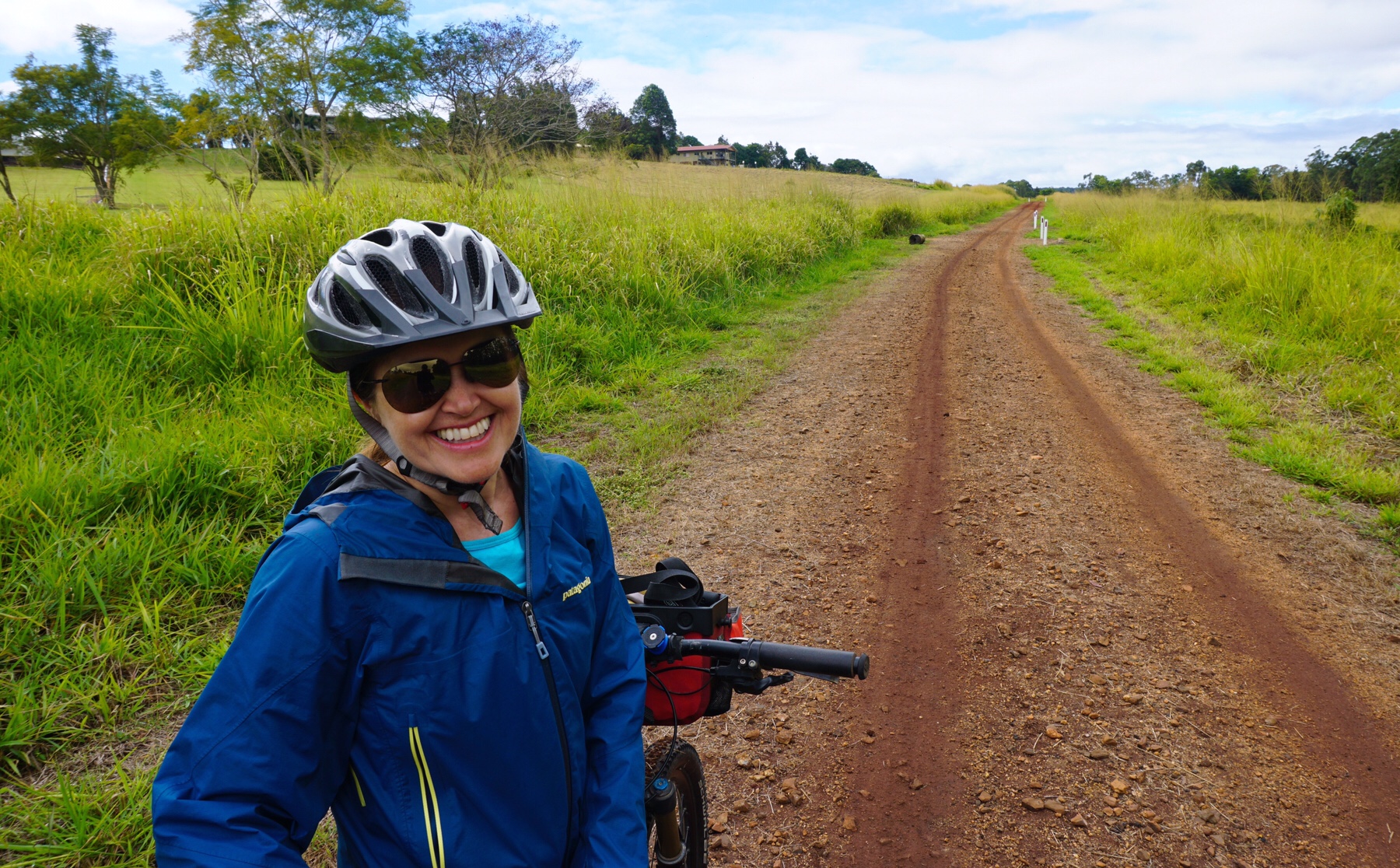 It was actually a great ride initially through a countryside of rolling hills, then we headed round a loop on some tarmac and back to base via a series of local mountain bike trails through the rainforest, ticking off just over 35km.
It was actually a great ride initially through a countryside of rolling hills, then we headed round a loop on some tarmac and back to base via a series of local mountain bike trails through the rainforest, ticking off just over 35km.
 A curry was called for after all that exertion, so our fellow Zoner Ken drove us into Atherton and we we finished our stay here with a great feed. We have really enjoyed the tablelands, apart from the weather, but tomorrow its time to head back down to the coast.
A curry was called for after all that exertion, so our fellow Zoner Ken drove us into Atherton and we we finished our stay here with a great feed. We have really enjoyed the tablelands, apart from the weather, but tomorrow its time to head back down to the coast. The market was great too. Alongside the stalls of fresh-from-the-farm vegetables and herbs were bakers, jewellers, artists (including musicians, painters, woodworkers, ceramic workers and potters), massage therapists, plants of all varieties, flowers and even fertilised eggs, chicks and chickens for sale. It all felt very authentically country.
The market was great too. Alongside the stalls of fresh-from-the-farm vegetables and herbs were bakers, jewellers, artists (including musicians, painters, woodworkers, ceramic workers and potters), massage therapists, plants of all varieties, flowers and even fertilised eggs, chicks and chickens for sale. It all felt very authentically country.
 Again, we didn’t get too far before Tassie decided it was time to return to the Zone. She always amazes me with her courage – as a 14 year old predominantly indoor/garden cat, she had not really travelled much before last September, but now she’s been right across Australia. She always knows where the safe Zone is, and keeps her wits about her, even when being dive bombed by birds…they don’t seem to understand she’s a lover not a catcher!
Again, we didn’t get too far before Tassie decided it was time to return to the Zone. She always amazes me with her courage – as a 14 year old predominantly indoor/garden cat, she had not really travelled much before last September, but now she’s been right across Australia. She always knows where the safe Zone is, and keeps her wits about her, even when being dive bombed by birds…they don’t seem to understand she’s a lover not a catcher! There are plenty of birds here. We have spotted pale yellow robins, firetails, finches galore, and lovely purple and green fruit doves feeding on the mandarins on and below the tree beside where we are camped. The little black and white Willy Wagtail is the feisty one, always flying at Tassie and frightening her back indoors. I guess he’s met some hungrier cats in his lifetime.
There are plenty of birds here. We have spotted pale yellow robins, firetails, finches galore, and lovely purple and green fruit doves feeding on the mandarins on and below the tree beside where we are camped. The little black and white Willy Wagtail is the feisty one, always flying at Tassie and frightening her back indoors. I guess he’s met some hungrier cats in his lifetime. Soon the cheese was calling, and off we went to the farm where Mr A tried some cheese and purchased a delicious (according to him) blue.
Soon the cheese was calling, and off we went to the farm where Mr A tried some cheese and purchased a delicious (according to him) blue. From here we drove a short way to another little national park – home to the Curtain Fig. This tree is a survivor in a small patch of remaining rainforest which was saved from the saw in the 1800s by the rocky surface, not ideal for grazing.
From here we drove a short way to another little national park – home to the Curtain Fig. This tree is a survivor in a small patch of remaining rainforest which was saved from the saw in the 1800s by the rocky surface, not ideal for grazing.  It is protected by a raised boardwalk, and pretty magnificent.
It is protected by a raised boardwalk, and pretty magnificent. Willie started to take us on a tour of his “backyard”, where his grandfather’s bones are buried and where he was birthed. He explained what they ate and drank, plucking plants and fruit for us to smell and feel, and talked about the seasonal migrations from the bush to the beach, at pains to point out they were not nomads but followed a set path of migration along the songlines.
Willie started to take us on a tour of his “backyard”, where his grandfather’s bones are buried and where he was birthed. He explained what they ate and drank, plucking plants and fruit for us to smell and feel, and talked about the seasonal migrations from the bush to the beach, at pains to point out they were not nomads but followed a set path of migration along the songlines. The knowledge of flora and fauna these people have accumulated over 40,000 years and passed on through stories, music and art is just incredible. He had Catherine mix up some seeds in her hand that are used to put a protective coating over a wound, while he had another lady rubbing together some leaves from the soap bush creating a cleaning compound that was antiseptic.
The knowledge of flora and fauna these people have accumulated over 40,000 years and passed on through stories, music and art is just incredible. He had Catherine mix up some seeds in her hand that are used to put a protective coating over a wound, while he had another lady rubbing together some leaves from the soap bush creating a cleaning compound that was antiseptic.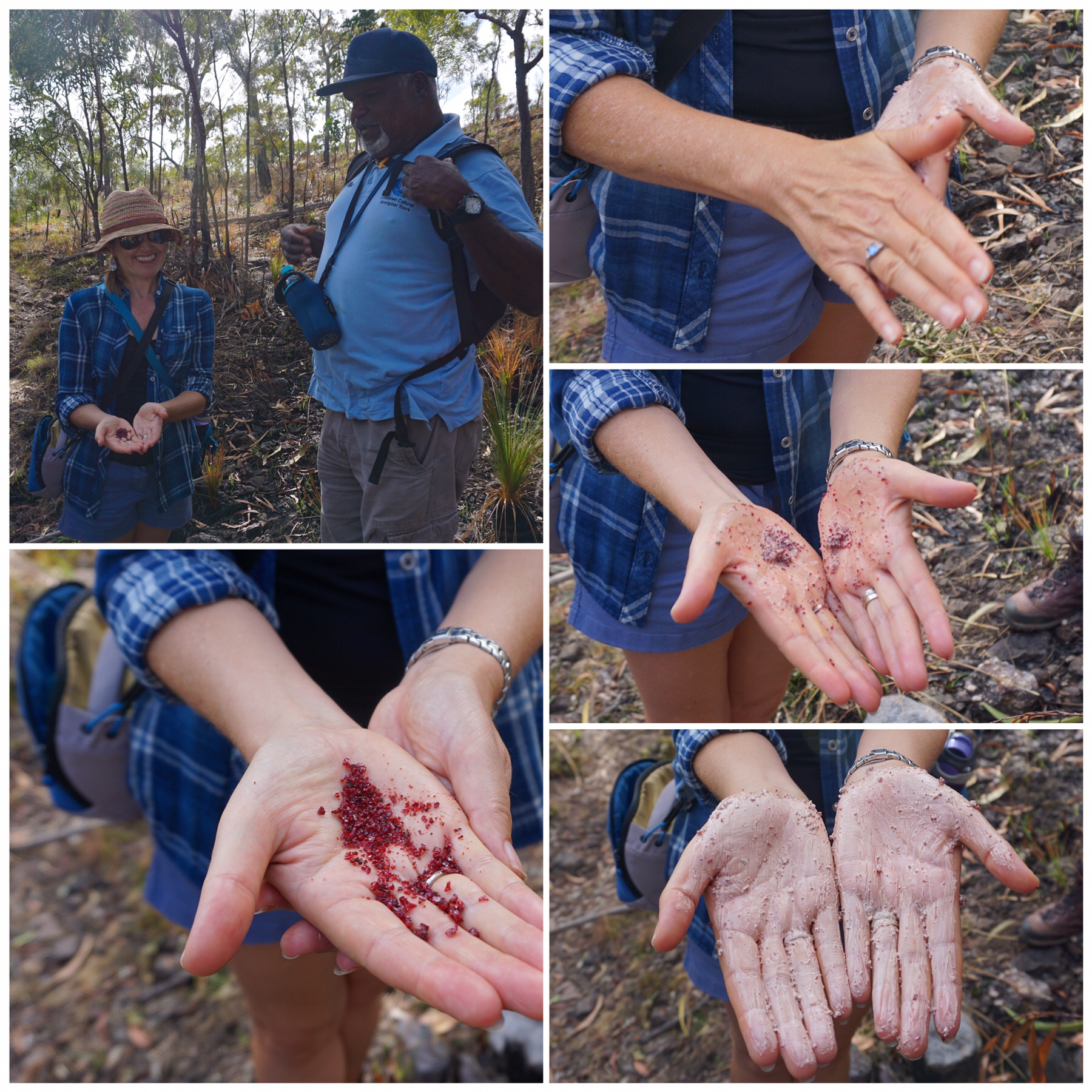
 We were led to a birthing cave and Willie explained the symbolism of some of the drawings, how they were painted and why. A big question the community is discussing is wether the drawings should be renewed, as they fade after a couple of thousand years. A couple of thousand! Incredible..these timeframes are mind boggling.
We were led to a birthing cave and Willie explained the symbolism of some of the drawings, how they were painted and why. A big question the community is discussing is wether the drawings should be renewed, as they fade after a couple of thousand years. A couple of thousand! Incredible..these timeframes are mind boggling.

 Catherine and I tried to take in as much as we could, but it was like walking into a library and having a teacher open a couple of books at random and read a few lines. We knew it was but a fleeting glance into a world we will never fully understand, but certainly appreciate and respect now even more what a trove of wisdom is there.
Catherine and I tried to take in as much as we could, but it was like walking into a library and having a teacher open a couple of books at random and read a few lines. We knew it was but a fleeting glance into a world we will never fully understand, but certainly appreciate and respect now even more what a trove of wisdom is there.
 If you come this way, support these efforts to help us all better understand and respect aboriginal culture. Willie Gordon can be found at Cooktown Cultural Aboriginal Tours – the information centre knows where to find him or indeed others like him.
If you come this way, support these efforts to help us all better understand and respect aboriginal culture. Willie Gordon can be found at Cooktown Cultural Aboriginal Tours – the information centre knows where to find him or indeed others like him.
 We took this as a good omen that we might see one of the rare and endangered Cassowary birds – at between 1.5 and 2 metres tall and up to 80kg, they would be hard to miss!
We took this as a good omen that we might see one of the rare and endangered Cassowary birds – at between 1.5 and 2 metres tall and up to 80kg, they would be hard to miss!

 From here we continued north, calling next in at Dubuji Boardwalk and Myall Beach. The short walk was very informative, and as always full of incredible sculptural rainforest trees and vines.
From here we continued north, calling next in at Dubuji Boardwalk and Myall Beach. The short walk was very informative, and as always full of incredible sculptural rainforest trees and vines.
 We drove up as far as the 4WD commencement of the Bloomfield Track which leads up to Cooktown, before turning and calling in to more short walks at Cape Tribulation and then Noah Beach.
We drove up as far as the 4WD commencement of the Bloomfield Track which leads up to Cooktown, before turning and calling in to more short walks at Cape Tribulation and then Noah Beach.
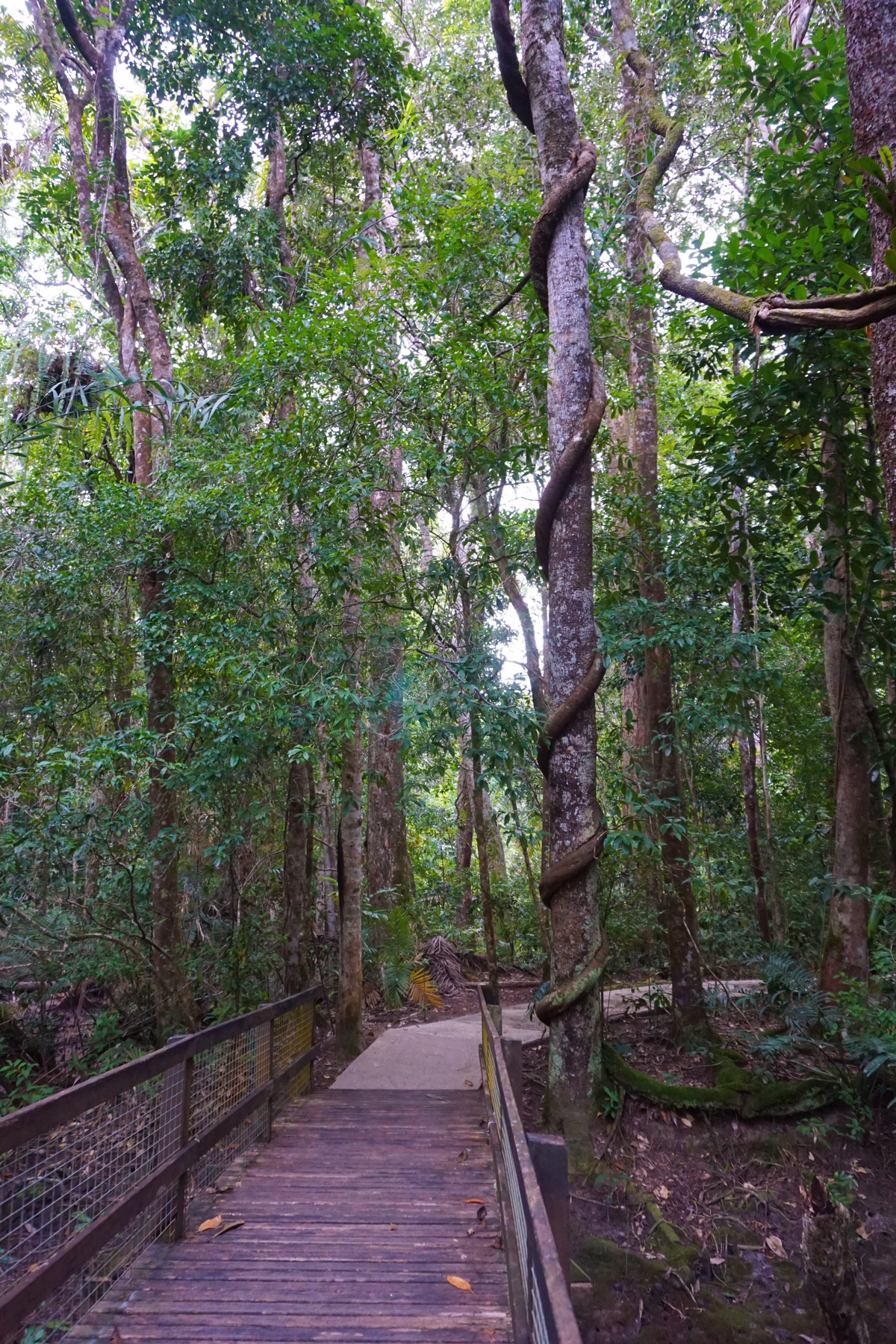

 There’s so much to learn about the rainforest, and incredible that this has been around since the time of dinosaurs, many of the plants changing very little in that time.
There’s so much to learn about the rainforest, and incredible that this has been around since the time of dinosaurs, many of the plants changing very little in that time. Oh and the Cassowaries? Nowhere to be seen…
Oh and the Cassowaries? Nowhere to be seen…

 The walk was a tip from the waiter at our restaurant last night. He did try to diplomatically point out it was quite a tough walk, casting his eye at me when he said that. Little did he know the young beast that lurks under this ageing frame.
The walk was a tip from the waiter at our restaurant last night. He did try to diplomatically point out it was quite a tough walk, casting his eye at me when he said that. Little did he know the young beast that lurks under this ageing frame. After nearly 3km of bush bashing up this path, we beat a tactical retreat. Three kilometres doesn’t sound like a lot, and its not, unless every step is fought uphill and against the scrub. So it was a slip and slide back down the path, with a “ouch” punctuating every few minutes from one of us.
After nearly 3km of bush bashing up this path, we beat a tactical retreat. Three kilometres doesn’t sound like a lot, and its not, unless every step is fought uphill and against the scrub. So it was a slip and slide back down the path, with a “ouch” punctuating every few minutes from one of us. Back at Newell Beach, birds were everywhere – Australasian Figbirds (yellow one with red eye band), Rainbow Bee Eaters, and honeyeaters:
Back at Newell Beach, birds were everywhere – Australasian Figbirds (yellow one with red eye band), Rainbow Bee Eaters, and honeyeaters: And down at the boat ramp a view towards Port Douglas looking tantalisingly close, but further by road.
And down at the boat ramp a view towards Port Douglas looking tantalisingly close, but further by road. After returning to the Zone we decided to bite the bullet and have a go at fixing our Dometic window, as the fly screen was failing to retract and flapping about. Now we had been given some tips by the ever useful resource of the Zoners Facebook group, but still, this was new territory for us. Screws were undone, and the window taken off, (quite a feat given I barely know one end of a screw driver from the other)! Thank goodness for my ever practical wife.
After returning to the Zone we decided to bite the bullet and have a go at fixing our Dometic window, as the fly screen was failing to retract and flapping about. Now we had been given some tips by the ever useful resource of the Zoners Facebook group, but still, this was new territory for us. Screws were undone, and the window taken off, (quite a feat given I barely know one end of a screw driver from the other)! Thank goodness for my ever practical wife. It was pretty obvious what had happened, one of the retaining lugs had fallen off the bottom. So that was pushed back on and after a few attempts we had it re-assembled, with a very timely phone call from Peter Thomson, a fellow Zoner with deep expertise from his past life with Bushtracker Caravans. Peter recommended we glue it to prevent future issues, so we took it off again and did so. The proof will be after 24hrs when the glue has dried, does it work? Your lives will be a chasm until then right?
It was pretty obvious what had happened, one of the retaining lugs had fallen off the bottom. So that was pushed back on and after a few attempts we had it re-assembled, with a very timely phone call from Peter Thomson, a fellow Zoner with deep expertise from his past life with Bushtracker Caravans. Peter recommended we glue it to prevent future issues, so we took it off again and did so. The proof will be after 24hrs when the glue has dried, does it work? Your lives will be a chasm until then right?